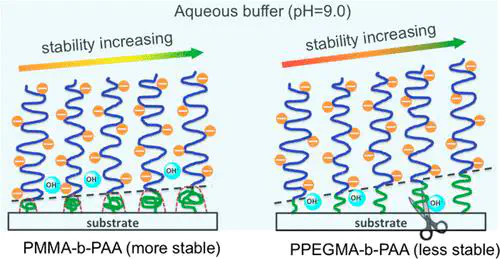Enhanced Stability of Surface-Tethered Diblock Copolymer Brushes with a Neutral Polymer Block and a Weak Polyelectrolyte Block. Effects of Molecular Weight and Hydrophobicity of the Neutral Block

Abstract
We study the stability of diblock copolymer brushes featuring a bottom neutral block, poly(methyl methacrylate) (PMMA) or poly(poly(ethylene glycol) methacrylate) (PPEGMA), and a top poly(acrylic acid) (PAA) block on flat silicon substrate. The polymer brushes are prepared by surface-initiated atom transfer radical polymerization (SI-ATRP). We use a combinatorial design featuring a molecular weight gradient in the bottom neutral block to investigate systematically the effect of the molecular weight of that block on the stability of the copolymer brush. We measure variations in dry thickness of the diblock copolymer brush by ellipsometry after different incubation times in aqueous buffer (pH = 9.0) as a function of thickness of the neutral block, indicating degrafting of the mechanically activated copolymer chains via hydrolysis of ester groups in the initiator and/or Si–O bonds that attach the polymer to the substrate. The stability of the diblock copolymer brushes is higher than that of PAA homopolymer brushes of the same molecular weight as the copolymer. Moreover, we establish that increasing the molecular weight of the neutral bottom PMMA block in PMMA-b-PAA brush shows higher stability than increasing the molecular weight of the bottom PPEGMA block in PPEGMA-b-PAA brush. Partial swelling of the bottom PMMA block (due to addition of a small amount of acetone) makes the degrafting of PMMA-b-PAA more pronounced. These findings suggest that the bottom water-insoluble polymer block plays an important role in governing the overall stability of the diblock copolymer brush.